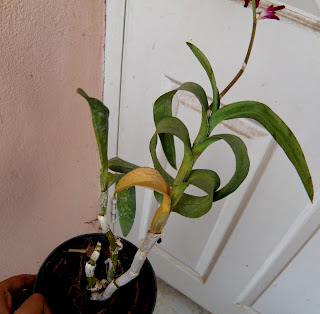Spring... the most beautiful season of the year where every plant has sprouts new growth, new leaves and every sign of a new year...
 |
| A young new shoot... |
For Orchids too, this is the best growing season with plants coming alive with new shoots. The first spring and the sudden on set of summer therein sprung a new surprise for us. Suddenly our plants leaves seemed to be getting wrinkled and the shoots were shrinking. It looked like our plants were suddenly looking weak. Plants which looked fresh and strong, looked like they were going to die. Frantically, we did a lot of searching and as usual got even more confused.
 |
| A dendrobium affected by lack of humidity... |
Finally we realized that the sudden change in temperature and the rapid drying due to the heat gave the orchid very less humidity to absorb. Moreover, Bangalore (where we are), has very less humidity even otherwise.
Identifying heat stress on your plant
Some of the tell tale signs of plant stress due to lack of humidity are :
1. Wrinkling and drooping of leaves
2. Shrinking of shoots
3. Leaves turning yellow
So, what was the solution? Watering them more often was the easiest but then, with the urban lifestyle, watering once itself was difficult enough. So we experimented with our dear plants over the years and are happy to share with you some of the solutions to an Orchid's Summer woes.
Tips to keep your orchids growing well in Spring and Summer:
1. Water your plants more often - It is never advisable to water your plants post sunset. The rest of the day just check if the medium is dry and if it is, water again. Now that's easy if growing orchids is all you do. If not, try our the other ones...
2. Humidity tray - A tray of water placed under the plant is what a humidity tray is. It lets the water evaporate and creates localized humidity for the plant. The only thing to watch out for is that the roots or the medium is not sitting in the water. We found the easiest humidity tray was an ice tray as the plant sat on the ridge while there was enough of water in the tray.
3. Move your plant to a cooler spot - With indoor plants like Phals, one of the best other things to do is to move the plant to a cooler location. Check your plants few times a day and remember that the idea is that the potting medium should be wet for at least 60- 70% of the day.
4. Give your plant more shade - For dendrobiums which get too much sun light (especially between 11 am - 4 pm), just move the guy to a different spot where they get less sunlight.
5. Repot the orchid - This is something we will cover in the blogs to come but overall if your medium is not retaining enough water, add more medium (coco chips or sphagnum moss) to augment the water retention. This though needs to be done with caution as there is a whole list of precautions to take when repotting an orchid.
After making these small adjustments, we had a closer look at our plants... Lo and behold, the plants were all sprouting new shoots, some spikes and all of them had regained strength. When they are growing, feed them a balanced fertilizer regularly (orange for TUOB customers).
Even we did get caught a bit off guard this year the temperatures in Bangalore surged to almost 35 C in Bangalore but then we got in to action, made some changes quickly and our plants were back doing what they do best... Growing... Which most definitely means a very colourful blooming summer ahead.
After making these small adjustments, we had a closer look at our plants... Lo and behold, the plants were all sprouting new shoots, some spikes and all of them had regained strength. When they are growing, feed them a balanced fertilizer regularly (orange for TUOB customers).
Even we did get caught a bit off guard this year the temperatures in Bangalore surged to almost 35 C in Bangalore but then we got in to action, made some changes quickly and our plants were back doing what they do best... Growing... Which most definitely means a very colourful blooming summer ahead.
See some of our plants growing this spring
 |
| A young shoot emerges from the base... sign of a healthy plant... |
 |
| A young shoot grows new roots... |
Try our tips and do let us know how your plant springs back to life and grows this spring which of course means a very colourful summer full of new blooms.
 |
| New roots for new shoots... notice the green tips? The plant stores water in them to help grow the new shoot |
For those who haven't yet tried growing an orchid, its never too late to fall in love. Visit www.indianorchids.in or visit us at facebook.com/indianorchids to buy your first orchid today.
You can also write to us at theurbanorchid@gmail.com for further details.





